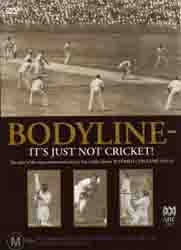Bodyline-It's Just Not Cricket! (documentary) (2002) |
|
Bodyline-It's Just Not Cricket! (documentary) (2002) |
|


|
| BUY IT |
| General | Extras | ||
| Category | Drama | Main Menu Introduction | |
| Rating |

|
||
| Year Of Production | 2002 | ||
| Running Time | 59:04 | ||
| RSDL / Flipper | No/No | Cast & Crew | |
| Start Up | Ads Then Menu | ||
| Region Coding | 1,2,3,4,5,6 | Directed By | None Given |
|
Studio
Distributor |
 Roadshow Home Entertainment |
Starring |
Don Bradman Douglas Jardine Harold Larwood Bill Woodfull |
| Case | Amaray-Transparent-Secure Clip | ||
| RPI | $29.95 | Music | Stuart Day |
| Video | Audio | ||
| Pan & Scan/Full Frame | None | English Dolby Digital 2.0 (384Kb/s) | |
| Widescreen Aspect Ratio | 1.78:1 | ||
| 16x9 Enhancement |
 |
||
| Video Format | 576i (PAL) | ||
| Original Aspect Ratio | 1.78:1 | Miscellaneous | |
| Jacket Pictures | No | ||
| Subtitles | None | Smoking | No |
| Annoying Product Placement | No | ||
| Action In or After Credits | No | ||
Now Bill Woodfull was as fine a man as ever went to wicket,
and the bruises on his body that day showed that he could stick it.
But to this day he's still quoted, and only he could wear it,
"there are two sides out there today and only one of them is playing cricket"
Paul Kelly - 'Bradman' 1986
Such was the impact that the tactic of 'Leg Theory', or as it is more commonly known, 'Bodyline' had on the world of cricket, that it gets a verse in a song. It was employed by the touring England cricket team of 1932-1933 under the leadership of Douglas Jardine, against Bill Woodfull's Australians. Moreover, it was a tactic devised to curb the free scoring run machine that was Don Bradman, and it possibly brought about the lowest moment in English/Australian relations.
During the 1930 tour of England, The Don had amassed so many runs that stopping him proved almost impossible, and when Bradman scored big, Australia invariably won the game. Captain Jardine decided that on the upcoming tour he would get speedsters Harold Larwood and Bill Voce to send deliveries down the leg-side and pitch them in short, so the batsmen had little option about where to play the ball. By stacking the field on the leg side, the chances of catching a gloved or hastily defended shot increased, not to mention the scoring rate dried up dramatically. Of course, one of the side effects of this tactic, with the ball aimed virtually at the body of the batsman, was that they would often get hit by the fast moving, fast rising ball. Hence the term 'Bodyline'.
Obviously released right in time for the current English tour of Australia, when cricket has once again become the focus of our sporting attention, this disc features a detailed documentary analysis of the whole 'Bodyline' saga. It features quite an in-depth account of just how the concept of Leg Theory came about, how Captain Jardine decided to implement it, the effect it had on the teams, and the aftermath it left on the game. There are a whole host of interviews with several social and cricket historians (just how does one get a job like that?), and with several of the family members of the players involved (none of whom are left with us, unfortunately). There is a reasonable quantity of archival footage from the first three tests of the summer of 1932-33, with the highlights undoubtedly being the Third Test in Adelaide when several players were hit, including wicketkeeper Bert Oldfield, who copped one in the head and was nearly knocked out. It was also here that Bill Woodfull made his famous quote about just who was playing the game and who wasn't. In fact, this quote is the subject of quite a bit of the story, as apparently his comments were said in private to the England team manager and somehow leaked to the press. The source of this leak has never been discovered, although a few theories are forthcoming in this documentary.
While the style and delivery are a little dry and dusty, cricket purists will enjoy and be fascinated by the story. It is undoubtedly the most detailed analysis of the Bodyline saga that I have seen.
This is really quite a lovely transfer. Presented in an aspect ratio of 1.78:1, it also benefits from being 16x9 enhanced. With the transfer containing a mixture of old and new footage, the quality is obviously going to differ greatly, but the new interview material is excellent, being sharp, clear, and brilliantly vibrant in colour. It is also presented using the full 1.78:1 screen. The older archival material suffers from being 70 years old. Scratched, muddy at times, and in brilliant black and white or sepia-tone, it is as expected. The very existence of much of this footage is enough of a wonder in its own right. This material is presented in an aspect ratio of approximately 1.33:1. It fills the centre of the 1.78:1 image, with a static background filling up the edges of the widescreen picture. Overall there are no traces of edge enhancement, and grain is absent in the new material and not a real issues with the older material. There is no low level noise in either.
Colour for the new interview footage is superb, benefiting from modern digital video equipment. It is vivid and vibrant with deep solid saturation. The archival footage from the 1930s is at the other end of the quality spectrum, being grainy and a mix of black and white and sepia-tone.
There are no MPEG artefacts. Video artefacts are limited to a couple of incidences of moiré effect, most notably on the collar of Bill Woodfull, Jnr when he is being interviewed (33:02-33:32 is the best example of this artefact). The rest of the new video footage is excellent and clean of any imperfections. The archival material suffers from pretty much every film artefact in existence, including scratches of varying lengths, blobs, blotches, and dirt. Nonetheless, it is still fascinating to watch.
Oddly, there are no subtitle streams present.
This is a single layered disc only, so there is no layer change to navigate as a result.
| Sharpness | |
| Shadow Detail | |
| Colour | |
| Grain/Pixelization | |
| Film-To-Video Artefacts | |
| Film Artefacts | |
| Overall |
A fairly basic audio selection graces this disc. We get an English Dolby Digital 2.0 soundtrack as the only option.
Dialogue is pretty much all this is about, being a narrative documentary. This is handled well with no obvious problems. There are also no audio sync issues.
There is a little background music, but it is barely noticeable.
There is no surround or subwoofer use at all.
| Dialogue | |
| Audio Sync | |
| Clicks/Pops/Dropouts | |
| Surround Channel Use | |
| Subwoofer | |
| Overall |
The standard promo piece for other ABC titles available.
NOTE: To view non-R4 releases, your equipment needs to be multi-zone compatible and usually also NTSC compatible.
This disc is not available in Region 1.
This is probably one for the cricket fanatics only. The subject matter and delivery tend to be a little on the dry side at times and with only a small amount of archival footage available, relies on interviews with historians and other stuffy academics. Still worth a look as it is most certainly the most definitive account of the Bodyline saga that I have seen.
The quality of the video is excellent (well, the new interview material is anyway). The older archival footage suffers from all the usual problems associated with 70 year old film.
The audio is nothing spectacular but handles the job required with ease.
There are no extras.
| Video | |
| Audio | |
| Extras | |
| Plot | |
| Overall |
| Review Equipment | |
| DVD | Loewe Xemix 5106DO, using RGB output |
| Display | Loewe Calida (84cm). Calibrated with Video Essentials. This display device is 16x9 capable. |
| Audio Decoder | Built in to amplifier/receiver. Calibrated with Video Essentials. |
| Amplification | Harmon/Kardon AVR7000. |
| Speakers | Front - B&W 602S2, Centre - B&W CC6S2, Rear - B&W 601S2, Sub - Energy E:xl S10 |